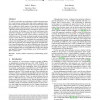Free Online Productivity Tools
i2Speak
i2Symbol
i2OCR
iTex2Img
iWeb2Print
iWeb2Shot
i2Type
iPdf2Split
iPdf2Merge
i2Bopomofo
i2Arabic
i2Style
i2Image
i2PDF
iLatex2Rtf
Sci2ools
116
click to vote
PPOPP
2016
ACM
2016
ACM
Benchmarking weak memory models
To achieve good multi-core performance, modern microprocessors have weak memory models, rather than enforce sequential consistency. This gives the programmer a wide scope for choosing exactly how to implement various aspects of inter-thread communication through the system’s shared memory. However, these choices come with both semantic and performance consequences, often in tension with each other. In this paper, we focus on the performance side, and define techniques for evaluating the impact of various choices in using weak memory models, such as where to put fences, and which fences to use. We make no attempt to judge certain strategies as best or most efficient, and instead provide the techniques that will allow the programmer to understand the performance implications when identifying and resolving any semantic/performance trade-offs. In particular, our technique supports the reasoned selection of macrobenchmarks to use in investigating trade-offs in using weak memory models....
Related Content
| Added | 09 Apr 2016 |
| Updated | 09 Apr 2016 |
| Type | Journal |
| Year | 2016 |
| Where | PPOPP |
| Authors | Carl G. Ritson, Scott Owens |
Comments (0)

